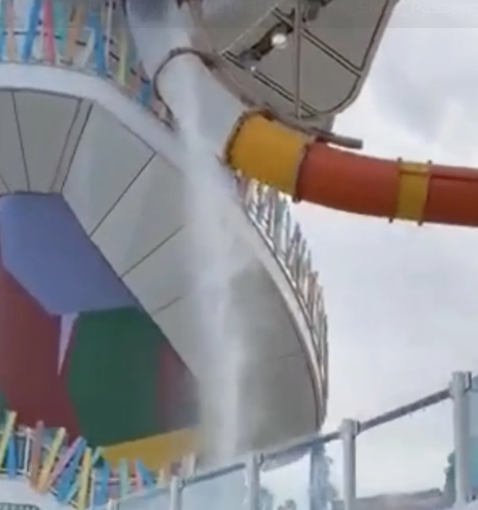- The Frightening Bold water slide malfunctioned on Icon of the Seas.
- A passenger was injured and guests horrified as they watched and filmed.
- An inquiry has been launched.
Passengers on board Icon of the Seas, the world’s largest cruise ship, faced chaos when an acrylic panel in the “Frightening Bolt” water slide shattered mid-ride, injuring a male guest.
Dramatic footage captured by fellow cruisers shows passengers screaming “Stop the slide!” as water flooded onto Deck 15, according to reports of the incident.
Eyewitnesses described seeing the rider’s leg and back “cut open pretty bad” by a jagged fragment—though the guest did not plunge through the panel breach and was reportedly in stable condition following onboard medical care.
Royal Caribbean quickly closed the slide for the remainder of the voyage and launched an internal investigation.
Slide Safety and the Icon’s Track Record
The “Frightening Bolt” is part of the ship’s much-promoted Category 6 Waterpark, boasting six groundbreaking slides—among them, the tallest at-sea drop, a trapdoor launch, and a full 360° loop.
While such attractions offer unparalleled thrills, water slide accidents on cruise ships remain exceptionally rare. A legal summary notes that when they do occur, causes often include inadequate maintenance, poor inspections, operator negligence, or overcrowding. Operators may face liability for injuries.
Icon of the Seas has an otherwise strong safety record. In June, the ship earned a perfect score of 100 from the U.S. Centers for Disease Control and Prevention (CDC) during a sanitation inspection.
But he vessel has experienced several alarming incidents in recent months—including a crew member who tragically stabbed a colleague before going overboard, and a guest who almost fell from an infinity pool.

What Happens Now
Royal Caribbean has already closed the slide and dispatched its engineering and safety teams to pinpoint the cause of failure—likely focusing on the acrylic panel’s material integrity, installation, and maintenance history.
The Icon of the Seas is U.S.-flagged and operating in U.S. ports, so authorities such as the U.S. Coast Guard may intervene. Significant safety incidents can trigger inspections or surveys, especially if they suggest design or maintenance shortcomings.
Depending on findings, the slide—or the broader waterpark—might remain offline pending repairs or redesign. Royal Caribbean may revise inspection schedules, enhance material specifications, and reinforce staff training on identifying early signs of structural stress. If a design flaw is detected, it could lead to retrofits across the fleet—or even new engineering standards for cruise-ship water attractions.
Though the injured guest’s condition is stable, the cruise line may face liability claims if negligence is determined.
Safety in the Spotlight
Cruise industry innovations—particularly features like onboard waterparks—are key to passenger appeal. But incidents like this highlight the importance of robust safety engineering, frequent inspections, and rapid response protocols.
Traditionally, cruise lines, regulators, and safety engineers collaborate closely to enforce compliance with design standards, inspection intervals, and emergency procedures.
Public confidence will hinge on transparency in how Royal Caribbean addresses the malfunction—and whether corrective action becomes a new safety benchmark aboard the Icon of the Seas and perhaps other ships with similarly ambitious attractions.








